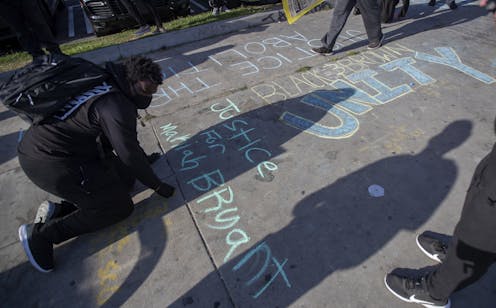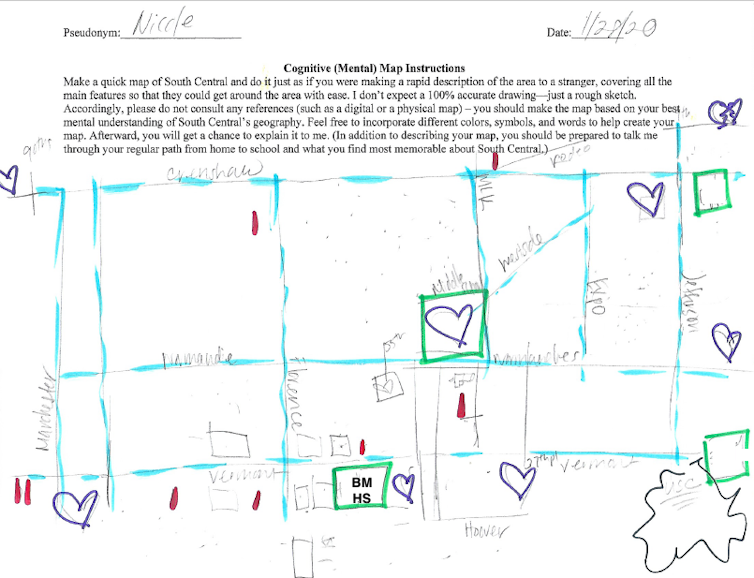Teachers in South Central LA who had personal ties to the neighborhood made better connections with
A sociologist asked public high school teachers to draw maps of the neighborhood where they teach. Those with more detailed maps also made stronger cultural connections with their students.

The Research Brief is a short take about interesting academic work.
The big idea
One way to examine a teacher’s personal connection to their students’ community is to ask them to create a hand-drawn map, based on memory, of the neighborhood where they teach. My study found that teachers whose maps represented personal ties to the community, including local businesses or cultural spaces, were observed to be more skilled at making connections to the everyday experiences of their students.
This supports previous research that shows the more connected teachers are to their students’ neighborhoods, the more authentically they can incorporate local resources, history and concerns into their classroom teaching. For example, they might incorporate interviews with students’ families into an English unit on immigration stories, or have geometry students design a ramp for elders with wheelchairs.
As a Ph.D. candidate studying how racism and inequality impact schools, I examined how a teacher’s connection to their school’s neighborhood influences their teaching. My research at a public high school in South Central Los Angeles combined classroom observations and interviews with teachers with the aforementioned maps.
All teachers in the study were dedicated to their craft and integrated best practices of a teaching approach known as “culturally relevant education,” which emphasizes social justice values and respect for student cultures. For example, culturally relevant education might involve encouraging students to discuss the changing community immigration patterns in class or having students conduct their own research on why particular groups were drawn to live in their community.
Still, I observed that teachers who were “in the know” made stronger links to students’ communities in their lessons.
For example, a teacher I’ll call Nicole created a detailed map with purple hearts representing places she felt at home – such as her elementary school and the home of extended family – and red drops where shootings had occurred.

I often observed Nicole’s intimate understanding of the community seep into her English lessons. For example, while teaching “The Absolutely True Diary of a Part-Time Indian,” a novel by Sherman Alexie, Nicole pushed her students to personally connect with the text. “Many [Indigenous folks] don’t leave their reservation, the community,” she said. “For us that would be South LA.”
Nicole’s impact on her students was evident in the quality of classroom discussions and student writing that I observed.
Meanwhile, another teacher I observed, whose map revealed much less familiarity and engagement with the community, was unaware of the controversy around attempts to rebrand South Central as SOLA, short for South Los Angeles – a move deemed by local residents as furthering the area’s gentrification. Therefore her lessons on racism in urban communities failed to make this local connection.
Why it matters
Due to teacher shortages and systemic underfunding of classroom and school-wide resources, urban schools often struggle to provide the quality of culturally relevant education present in Nicole’s classroom.
Culturally relevant education has been linked to many positive academic outcomes, including gains in literacy, math and English language test scores. The same research has also shown that when youth feel engaged in classroom lessons, they score higher on tests and other assignments.
What still isn’t known
Given that culturally relevant education seeks to empower students to think critically about the assets and challenges present in their communities, its effectiveness is not easily captured on standardized tests. More research is needed to examine its long-term impacts. Without this evidence, schools and districts may not fully invest in implementing it.
More research is also needed on teacher preparation programs that cultivate community connectedness in future teachers. Ball State University’s Schools Within the Context of Community program, for example, matches prospective teachers with community mentors as part of their training. At the Aquetza Academic Summer Program at the University of Colorado Boulder, teachers in training regularly reflect on their practice while working to serve their mostly Latino students.
What’s next
I will return to Nicole’s school in the fall of 2021 to continue to document the relationship between community connectedness and teaching. With schools reopening for in-person instruction, I will also gather the perspectives and experiences of families, staff and returning students.
[You’re smart and curious about the world. So are The Conversation’s authors and editors. You can get our highlights each weekend.]
Julio Angel Alicea does not work for, consult, own shares in or receive funding from any company or organisation that would benefit from this article, and has disclosed no relevant affiliations beyond their academic appointment.
Read These Next
West Antarctica’s history of rapid melting foretells sudden shifts in continent’s ‘catastrophic’ geo
A picture of what West Antarctica looked like when its ice sheet melted in the past can offer insight…
How the ‘slayer rule’ might play a role in determining who will inherit wealth from Rob Reiner and h
These rules have a long history in the United States. They played a role in the notorious murders by…
The celibate, dancing Shakers were once seen as a threat to society – 250 years later, they’re part
‘The Testament of Ann Lee,’ Mona Fastvold’s 2025 film, depicts part of the long history of Shaker…






